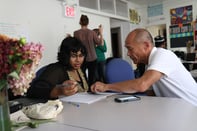Published on
Student-Centric and Data-Driven: Designing the Institution to Support Success

The conditions in the two-year college environment have changed significantly in recent years. Many of these colleges are open-enrollment institutions, however their goalposts for success have shifted from access to completion. At the same time, state funding has declined significantly, but given the demographic these institutions serve and government regulations, making up that decline through tuition increases is challenging and, in some cases, impossible. In this interview, Chris Bustamante reflects on how his college has recalibrated to ensure they’re helping students meet their goals in this challenging environment.
The EvoLLLution (Evo): Why has the focus on student retention and completion at two-year institutions grown so much in recent years?
Chris Bustamante (CB): The focus on retention and completion has grown because our accreditors and the federal government are holding us more accountable. There’s a broader interest in ensuring that students are completing their programs, preparing them for the labor market, for university transfer, or for a certification or credential that has market value.
This is something we’ve been working on at a local and national level. The American Association of Community Colleges published the report, Reclaiming the American Dream several years ago that addressed the fact that for many years community colleges mainly focused on access with more limited attention paid to retention, persistence and completion. Today, there is at least equal—if not more—emphasis on persistence, retention and completion, and that focus is grounded in data that guides our progress.
In Lumina Foundation’s Stronger Nation report, it states that in Arizona alone, nearly 900,000 adults have some college credits but no degree. We need to address this need by helping people gain college credit for their knowledge and experience through options such as credit for prior learning, credit by exam and other offerings—which will help propel them toward a credential or degree and, at the same time, raise the attainment level of our region and our state. Our state has an attainment goal of 60 percent and is currently at 42 percent, so we’re working toward increasing that attainment rate not only for our own institutions, but on behalf of the state of Arizona.
Also, when it comes to the increased focus on retention and completion, I think it has grown in recent years because resources are more diminished than they have been before. In Arizona, urban community college districts receive zero funding from the state. They no longer provide funding to us, so as a result we’re having to refocus our energy on maximizing the effectiveness of the resources we receive through tuition and property tax revenues and as we all know, it is more cost-efficient and productive to retain students than to recruit new ones.
Evo: What are some of the unique challenges open-access institutions face when it comes to retaining and graduating students?
CB: Community colleges accept 100 percent of the high school graduating class every year. Yes, providing access is critical and our challenge is to serve everyone the best that we can, but we also need to work harder to support persistence, retention and completion efforts. We can do that if we’re not trying to be all things to all people. In the Maricopa Community Colleges system, we have 10 individually accredited colleges, which each focus on those areas that they do really well.
At Rio for example, we work well with online students, workforce partners and workforce development, under-served populations, early college students and prison populations. We are the largest single provider of online education with more than 27,000 online learners every year. We have more than 7,000 early college students through 42 high school partners in the local K-12 system. We have nearly 30 business and industry partners participating in credit-for-training programs and we also have a corporate college for non-credit customized workforce training which has served nearly 100 business, government and industry partners since it was created in 2013.
We’re really focused on finding our place within the ecosystem, and more institutions need to do that too—especially when it comes to identifying what they do well. We know what we do well, and want to build on that—so we refer students across the system depending on their needs and the offerings that are available. For example, if someone comes to us looking for healthcare training in sonography or to become a physical therapy assistant, we recommend them to Gateway Community College, which is four miles from us and specializes in healthcare fields.
At Rio we create access and provide general education courses—especially if students need the flexibility we can provide—to take care of their prerequisites or fill program requirements toward a degree at another college or university. We also have a few unique ways to remove barriers and provide flexibility for our diverse student populations. Rio has more than 44 start dates a year and we guarantee that we will never cancel an online class, so that students can depend on us to provide the classes they need to complete their program. We built our model to be scalable and serve many people, and educate nearly 55,000 students every year across all our markets, which is impressive for one college to do.
Evo: Is the graduation rate necessarily indicative of student success, given the growing value of alternative credentials like certificates and the number of students who transfer to a four-year institution before earning their associate’s degree?
CB: We have focused on certificate programs for a number of years, and those certificates through a stackable credentialing model, can lead into a degree program. In fact, the vast majority of credentials that students earn with us are certificates, not degrees. Last year, we awarded 675 associate’s degrees, 4,832 certificates, 316 Arizona general education curriculum awards—those are the GenEd curriculum awards—46 academic certificates and 253 GEDs that help under-served populations bridge to higher education or other credentials.
We also had 7,277 transfer students transfer a total of 183,730 credits just last year to Arizona’s public universities. That’s the power of understanding who you serve and the important place you hold in an ecosystem. Arizona has only three public universities, and our community college system has established seamless transfer and articulation agreements which make it easy for students to transfer credits. So, once a credit is earned and transferred, it’s automatically accepted by the universities.
These transfer agreements also make a big impact on our dual enrollment students, who graduate high school with numerous college credits. Last year 64 Rio Salado dual enrollment students earned an associate degree before graduating from high school. Transferring their credit hours to the university is critical because it accelerates their time to completion and saves them and their family money.
Good transfer articulation pathways between community colleges and universities make a huge difference for completion, especially through online concurrent enrollment programs where students take courses with us to fulfill degree requirements beyond high school to complete their degree or credential at another institution. Of course, these kinds of enrollments are difficult for us to receive credit for in terms of how we’re helping students complete their credentials. That is why data systems between institutions are really important statewide and nationally. We need to have these systems in place so that we know how we have contributed to helping students complete their program of study.
Rio has provided a number of ways to help people to get into the workforce, and a number of other ways that allow people to overcome their barriers by making higher education more flexible and affordable. These systems are critical to creating a wider understanding of the impact different institutions make, especially at the community college level.
Evo: With so many students varying so significantly by demographic and goals, how do ensure that your institution is able to deliver a personalized experience?
CB: Rio strives to ensure that students have the support they need within their programs and courses. We have teams dedicated to specific student populations—such as, online, dual enrollment, incarcerated re-entry, for-credit occupational programs, active military and veterans—to focus on what we can do to improve their experience. We also believe in a continuous improvement process here. We’re big believers in Total Quality Management and business processes. We call it the plan, do, check, act cycle—ensuring that what we do is evaluated and improved upon.
Gaps are identified from student feedback when reviewing systems and processes, but are typically discovered through the use of data. We collect and analyze data to tell us where gaps might exist and where we need to shore up our support for students, curriculum, compliance and more.
To support these efforts, we have a number of systems working together. We have our learning management system, RioLearn, which improves the flexibility and convenience of online learning and helps scale access and support mechanisms for individuals who are looking to earn a degree or certificate. We also built a degree map called Rio Compass that helps students and staff ensure that students stay on track to completion. We have analytics through our RioPACE system, housed within RioLearn, and an additional dashboard that helps students track their class progress. Using analytics to provide these insights range from strategic to granular, helping us to deliver these kinds of personalized experiences and interventions at scale.
Our faculty are also very involved, ensuring that they can deploy interventions based on individual student engagement and historical data from previous students who have been successful in the course. This data also helps us improve and track how our services are making a difference on persistence and retention. The Gates Foundation, through an EDUCAUSE grant, helped us to focus on student success, shore up our processes, enhance and develop systems and outreach to students, and ensure that we are providing high-touch services when needed. We also have peer mentors to reach these students, providing support when necessary. As part of the grant we set goals to improve year-to-year persistence and increase associate degree completion rates by 50 percent within five years for Pell-eligible students. It’s a tall order but it is certainly a goal we’re working toward achieving.
There are also a number of other grants that we’re involved with that are helping us to build upon what we learned. We usually pilot a new initiative with a cohort of students and once we’ve learned what works, we then expand it out to the rest of the student population. We’ll hit and miss, but when we get it right, we scale up these innovations. That means we’re always in this experimentation phase exploring new ways to serve students better online and in-person.
Evo: How would you respond to criticisms of student success initiatives that claim students shouldn’t gain a postsecondary credential if they’re not able to find critical resources by themselves?
CB: Awareness of student resources is being pushed out initially to our students through student success seminars and New Student Orientation which familiarizes them with RioLearn, student services, and best practices of how to be a successful learner. We know that people come to us who haven’t been to college before, or perhaps it has been a long time, and don’t always know what resources are available to them. Even when I was a community college student, one of the challenges I experienced was understanding what was available to me. There were people that I could reach out to—there were advisors, an advisement and a tutoring center—but you had to look for those resources.
It’s important we make sure students realize they don’t have to go it alone and be aware of available resources so that they can be well equipped to achieve their goals. They still have to get through their program, make the grade, and earn their credential or certificate. We know that students who don’t persist and complete feel that they have a barrier that they can’t get around. That’s why at Rio we have the flexibility of more than 44 start dates a year. That’s also why we have a scholarship fund to help people with small expenses when they need it. We have many kinds of mechanisms to help people get around their barriers when life gets in the way.
Frankly, if you’re in this work but are not fully committed to student success, then you are not going to be successful and neither are your students. This is a commitment that we make to our students, and in return we ask that they make a commitment to successfully complete their programs. We all benefit from this. The first-generation student breaks the cycle for their whole family, and then others use them as a model to pattern their lives after. This work gives you a sense about what is really important, connecting the dots for people to have an opportunity to succeed.
Evo: What advice would you share with other two-year college leaders trying to drive persistence and completion rates at their own institutions?
CB: What is most needed is to listen and focus on the needs of students. Then, build programs and staffing around those needs, remove barriers, and provide the support needed for them to achieve their goals. Too often, higher education institutions place their own needs first and then hope that students will come, based on the schedules and programs they choose to offer. We also need to review the research and studies that are available to identify best practices which positively impact retention and completion, and then employ those strategies within our organizations.
Additionally, it’s critical to be data-driven. Have the data speak about what is really needed, identify where students are on their pathway, how many are persisting, being retained, and how that is impacting completion, and this all leads to the goal of helping your region’s economic growth.
Helping people obtain meaningful jobs that matter for your community is one major reason why we are here, so if we can connect all those dots, it is really about investing in our students and our communities. Sometimes that takes a lot of restructuring, refocusing and retooling, but if you’ve got your sights set on the right things, and you learn a lot along the way, and you do more of what works, you will succeed.
This interview has been edited for length and clarity.
Author Perspective: Administrator
Author Perspective: Community College


